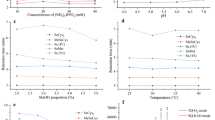Abstract
Development of a method for very low level selenium determination in water soluble protein and peptide fractions, obtained after various separation procedures, is presented. A hydride generation atomic fluorescence spectrometry (HG-AFS) detection system was optimised and the influence of Cu(II), Sb(V), As(III) and HNO3 interferences in the measurement of Se by HG-AFS was investigated. A destruction procedure using HNO3 and H2O2 was also optimised and the average recovery of the digestion of a solution of selenomethioneine was 92 ± 4% (n=14). Combination of this digestion with the detection system gave reliable results. Accuracy was tested by comparison with two independent methods. A very low detection limit (DL) of 0.2 ng/g of measuring solution was achieved. The whole procedure from weighing to measuring was performed in the same Teflon tube. The addition of HNO3 to the fractions before long term storage at -20°C was necessary to prevent adsorption on the test tubes.
Selenium was measured in water soluble protein and peptide fractions obtained after extraction, and Sephadex G-75 chromatography performed on liver samples from: i) hens exposed to As2O3, ii) hens fed with a high fat feed and iii) the certified reference material dogfish liver (CRM DOLT-2). Because of the very low DL we were able to observe the Se distribution in chromatographic fractions of samples of organisms which were not exposed to excess amounts of Se. The presence of selenium associated with metallothioneins was observed.






Similar content being viewed by others
References
Reilly C (1996) Selenium in food and health. Blackie Academic and Professional, London
Olivas RM, Donard OFX (1994) Anal Chim Acta 286:357
Önning G, Bergdahl IA (1999) Analyst 124:1435
Chassaigne H, Chery CC, Bordin G, Rodriguez AR (2002) J Chromatogr A 976:409
Stockwell PB, Corns WT (1994) Analyst 119:1641
Dedina J (1995) Hydride generation atomic absorption spectrometry. Wiley, London
Klaassen CD (1980) Heavy metals and heavy-metal antagonists. In: Gilman AG, Goodman LS, Gilman A (eds) The Pharmacological basis of therapeutics. Macmillian, Basingstoke, UK
Holcman A, Stibilj V(1997) Arch Environ Contam Toxicol 32:407
Falnoga I, Stibilj V, Tušek-Žnidarič M, Šlejkovec Z, Mazej D, Jaćimović R, Ščančar J (2000) Biol Trace Elem Res 78:241
Bremner I, Beattie JB (1990) Annu Rev Nutr 10:63
Kreppel H, Bauman JW, Liu J, McKim JM, Klaasen CD (1993) Fundam Appl Toxicol 20:184
Vadnjal R, Stibilj V, Holcman A, Dermelj M (1997) Zb Bioteniške Fak 70:195
NRC (National Research Council) (1994) Nutrient requirements of poultry. National Academy Press, Washington
De Corte F, Van Sluijs R, Simonits A, Kučera J, Smodiš B, Byrne AR, De Wispelaere A, Bossus D, Frana J, Horak Z, Jaćimiović R (2001) Fresenius J Anal Chem 370:38
Van Elteren JT, Šlejkovec Z, Das HA (1999) Spectrochim Acta Part B 54:311
PSA Application Note 054, PS Analytical LTD Kent
Tam GKH, Lacroix G (1982) J Assoc Off Anal Chem 65:647
Ding WW, Sturgeon RE (1997) Anal Chem 69:527
Kos V, Veber M, Hudnik V (1998) Fresenius J Anal Chem 360:225
Krynitsky AJ (1987) Anal Chem 59:1884
Gomez Ariza JL, Morales E, Sanchez-Rodas D, Giraldez I (2000) Trends Anal Chem 19:200
Stibilj V (1994) PhD thesis. University of Ljubljana
Dermelj M, Hancman G, Gosar A, Byrne AR, Kosta L (1985) Vestn Slov kem druš 32:127
Stibilj V, Dermelj M, Byrne AR (1996) Microchim Acta 123:311
Sabé R, Rubio R, Garcia-Beltran L (2001) Anal Chim Acta 436:215
Mazej D, Falnoga I, Stibilj V (2003) Acta Chim Slov 50:185
Prohaska C, Steffan I, Pomazal K, Torvenyi A (2000) J Anal At Spectrom 15:97
Tiran B, Tiran A, Rossipal E, Lorenz O (1993) J Trace Elem Electrolytes Health Dis 7:211
Harrison I, Littlejohn D, Fell GS (1996) Analyst 121:189
Mounicou S, McSheehy S, Szpunar J, Potin-Gautier M, Lobinski R (2002) J Anal At Spectrom 17:15
Gammelgaard B, Jessen KD, Kristensen FH, Jøns O (2000) Anal Chim Acta 404:47
Farrant TJ (1997) Practical statistics for the analytical scientist. RSC, Cambridge, UK
Mazej D, Stibilj V, Falnoga I (2003) Book of abstracts. XXXIII Colloquium Spectroscopicum Internationale, Granada 7–12.9.03, in press
Falnoga I, Kobal AB, Stibilj V, Horvat M (2002) Biol Trace Elem Res 89:25
Quevauviller P, De la Calle-Guntinas MB, Maier EA, Camara C (1995) Microchim Acta 118:131
Logar M, Horvat M, Falnoga I, Stibilj (2000) Fresenius J Anal Chem 366:453
Brigelious Flohé R (1999) Free Radic Biol Med 27:951
Falnoga I, Stibilj V, Tušek-Žnidarič M, Mazej D, Ščančar J (1999) Working Report No. 8179. Jožef Stefan Institute
Mazej D. (2002) Masters thesis. University of Ljubljana
Takatera K, Osaki N, Yamaguchi H, Watanabe T (1994) Anal Sci 10:567
Ferrarello CN, Fernandez de la Campa MR, Carrasco JF, Sanz-Medel A (2001) Spectrochem Acta, Part B 57:439
Viljoen AJ, Tappel AL (1988) J Inorg Biochem 34:277
Acknowledgements
We would like to thank Drs. Zdenka Šlejkovec and Johannes van Elteren for their kind introduction to the HG-AFS technique. The Ministry of Education, Science and Sport of the Republic of Slovenia is thanked for financial support through the programmes P0–0531 "Biological and Geochemical Cycles" and P0–0532 "Radiochemistry and Radioecology".
Author information
Authors and Affiliations
Corresponding author
Rights and permissions
About this article
Cite this article
Stibilj, V., Mazej, D. & Falnoga, I. A study of low level selenium determination by hydride generation atomic fluorescence spectrometry in water soluble protein and peptide fractions. Anal Bioanal Chem 377, 1175–1183 (2003). https://doi.org/10.1007/s00216-003-2182-9
Received:
Revised:
Accepted:
Published:
Issue Date:
DOI: https://doi.org/10.1007/s00216-003-2182-9




